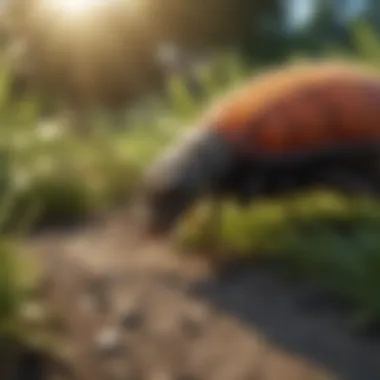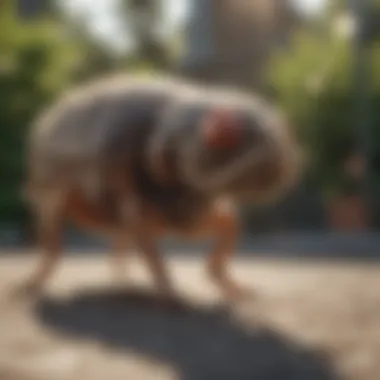Expert Strategies for Creating a Flea-Free Yard: A Comprehensive Guide


Preventive Pest Control Strategies
When it comes to keeping fleas out of your yard, preventive pest control strategies play a crucial role in ensuring a flea-free environment for your family and pets. Starting with house exterior protection, it is essential to focus on sealing cracks effectively to prevent pests from entering your home. Clearing debris regularly is also important as it eliminates hiding spots for fleas and other pests. Additionally, implementing measures to stop pests from entering your home in the first place can significantly reduce the risk of infestations.
Yard maintenance is another key aspect of keeping fleas at bay. By establishing essential yard care routines such as mowing the lawn regularly and eliminating standing water, you create an environment that is less hospitable to fleas. Utilizing methods like natural repellents and pest-control plants can also help in maintaining a pest-free yard.
Indoor cleanliness plays a critical role in flea prevention. Adopt expert cleaning tips and techniques to ensure that your indoor spaces remain pest-resistant. Regularly vacuuming carpets, cleaning pet bedding, and decluttering areas where pests can hide are some effective measures to deter fleas.
Efficient garbage disposal practices are paramount in preventing flea infestations. Proper waste disposal methods not only keep your yard clean but also reduce attractants for pests. Emphasize the importance of disposing of garbage properly to curb flea breeding grounds. Other innovative pest prevention strategies may include utilizing natural predators or creating barriers to deter pests.
Understanding Fleas and Their Behavior
In this comprehensive guide on keeping fleas out of your yard, understanding the behavior of fleas plays a pivotal role in effectively combating infestations. By delving into the intricacies of flea behavior, homeowners can adopt targeted strategies to prevent and eradicate these pesky parasites. Shedding light on the patterns of fleas not only enhances awareness but also empowers individuals to take proactive measures in safeguarding their yards. This section serves as a foundational piece in the battle against flea infestations, offering insights that are essential for maintaining a pest-free environment.
Introduction to Fleas
When exploring the realm of fleas, understanding their basic characteristics becomes imperative for implementing effective control measures. By unraveling the specifics of flea anatomy, feeding habits, and unique adaptations, individuals can gain a deeper appreciation for the challenges posed by these tiny insects. Delving into the lifecycle of fleas illuminates the stages of development from egg to adult, highlighting key points where intervention can disrupt their reproductive cycle and limit their population in the yard.
Basic characteristics of fleas
The basic characteristics of fleas encompass their small size, agile nature, and specialized mouthparts designed for piercing and sucking blood. These attributes enable fleas to swiftly move through fur and swiftly feed on their host, making them adept parasites with a remarkable ability to reproduce rapidly. Understanding these characteristics allows homeowners to identify potential hotspots and focus on targeted intervention strategies to prevent infestations.
Lifecycle of fleas
The lifecycle of fleas consists of four stages - egg, larva, pupa, and adult - each with distinct behaviors and vulnerabilities. By comprehending the intricacies of this lifecycle, individuals can pinpoint the most susceptible points for intervention, such as targeting areas where eggs are laid or disrupting the pupal stage to inhibit the emergence of new adult fleas. This knowledge is instrumental in formulating a proactive approach to controlling fleas and curtailing their proliferation in the yard.
Behavioral Patterns of Fleas


Exploring the behavioral patterns of fleas unveils crucial insights into their survival strategies and reproductive habits. By analyzing how fleas seek hosts, reproduce, and navigate their environment, homeowners can anticipate potential infestation risks and deploy countermeasures effectively. Understanding the nuances of flea behavior equips individuals with the information needed to disrupt their activities and prevent adverse consequences in their yard.
Host-seeking behavior
Fleas exhibit a distinct host-seeking behavior characterized by their ability to detect warmth, movement, and exhaled carbon dioxide emitted by potential hosts. This behavior enables fleas to locate and infest suitable animals for feeding, propagating their population and posing a threat to pets and humans alike. By grasping the mechanisms behind host-seeking behavior, individuals can proactively implement measures to repel fleas and protect their furry companions from infestation risks.
Reproduction habits
The reproductive habits of fleas are marked by their rapid rate of egg-laying, with female fleas capable of producing hundreds of eggs within a short timeframe. This prolific reproductive capacity underscores the urgency of addressing infestations promptly to prevent exponential growth in flea numbers. By understanding the intricacies of flea reproduction, homeowners can prioritize strategies that target breeding sites and disrupt the lifecycle, curbing the spread of fleas and maintaining a pest-free yard for their loved ones.
Identifying Flea Infestation in Your Yard
In this section of the comprehensive guide on keeping fleas out of your yard, we delve into the crucial aspect of identifying flea infestations. Understanding and recognizing the signs of a flea presence in your outdoor space is paramount to effectively combating these pests. By being vigilant and knowledgeable about flea infestation indicators, you can proactively protect your family and pets.
Signs of Flea Infestation
Symptoms in Pets
Symptoms in pets serve as significant red flags when it comes to detecting flea infestations. The key characteristic of pets displaying symptoms such as excessive scratching, skin irritation, and hair loss is their direct interaction with the outdoor environment. These symptoms, while uncomfortable for pets, can provide valuable insights into potential flea issues within your yard. By observing your pet's behavior and physical condition closely, you can promptly address any flea problems they may be experiencing.
Visible Signs in the Yard
Visible signs in the yard are essential markers of flea infestation presence. The key characteristic of visible signs, like flea dirt on pet bedding or in grassy areas, is their link to potential breeding grounds for fleas. By spotting these signs, homeowners can pinpoint areas of high flea activity and focus their pest control efforts effectively. While these signs may not always be overt, their presence warrants attention to prevent further infestations.
Understanding Flea Hotspots
In the realm of flea prevention, understanding flea hotspots is crucial for maintaining a pest-free yard environment. By identifying areas favored by fleas and common hiding spots, homeowners can adopt targeted strategies to minimize flea populations and safeguard their outdoor spaces.
Areas Favored by Fleas


Areas favored by fleas include shaded regions, moist areas, and spots with organic debris. The key characteristic of these areas is their suitability for flea survival and reproduction. Understanding why fleas prefer these locations allows homeowners to focus on treating and monitoring specific hotspots effectively. By addressing conducive environments for fleas, individuals can disrupt the pests' reproduction cycles and reduce infestation risks.
Common Hiding Spots
Common hiding spots for fleas encompass outdoor structures, vegetation, and pet resting areas. The key characteristic of these spots is their proximity to hosts and abundant harborage opportunities for fleas. Recognizing these hiding spots enables proactive flea control measures and minimizes the chances of infestations spreading. By targeting common hiding spots, homeowners can create a less hospitable environment for fleas and mitigate potential infestation risks in their yards.
Effective Strategies for Flea Prevention
In the pursuit of maintaining a flea-free yard, effective strategies for flea prevention play a pivotal role. By implementing comprehensive preventative measures, one can significantly reduce the risk of flea infestations, safeguarding the well-being of both pets and family members. This section delves into key elements, benefits, and considerations surrounding effective strategies for flea prevention.
Maintaining Yard Hygiene
Regular lawn mowing
Regular lawn mowing stands out as a fundamental aspect of yard maintenance to deter fleas. This practice involves trimming the grass to an optimum height regularly. The significance of regular lawn mowing lies in reducing the favorable harborage areas for fleas and other pests that thrive in tall grass. By keeping the grass short, sunlight and airflow penetrate better, creating an unfavorable environment for flea survival. The unique feature of regular lawn mowing lies in its simplicity yet efficiency in minimizing flea habitats. While it requires consistent effort, the benefits of reduced flea presence and improved overall yard aesthetics make it a popular choice.
Removing organic debris
Another crucial element in maintaining yard hygiene to prevent fleas is the removal of organic debris. Organic debris serves as a breeding ground for fleas, providing them with ample hiding spots and sustenance. By clearing organic debris such as fallen leaves, grass clippings, and branches, one eradicates potential flea habitats within the yard. The key characteristic of removing organic debris is its direct impact on eliminating flea breeding grounds, consequently reducing the likelihood of infestations. This practice's unique feature lies in its role in disrupting the flea lifecycle, interrupting their ability to reproduce and thrive. While it requires regular upkeep, the advantages of a cleaner yard and diminished flea population outweigh any disadvantages.
Natural Remedies and Repellents
Beneficial plants
Incorporating beneficial plants in your yard can serve as a natural flea repellent, enhancing the effectiveness of flea prevention strategies. These plants boast properties that naturally repel fleas, acting as a botanical line of defense against infestations. The key characteristic of beneficial plants is their ability to emit scents or substances that deter fleas and other pests, contributing to a pest-resistant environment. Their unique feature lies in providing a chemical-free and environmentally friendly approach to flea control. While the advantages of using beneficial plants include their low maintenance and long-term efficacy, potential disadvantages may revolve around specific plant care requirements.
Essential oils
Essential oils offer another natural remedy for flea prevention, with certain oils known for their repellent properties against fleas. When strategically applied or diffused in the yard, essential oils can create a deterrent effect, discouraging fleas from inhabiting the area. The key characteristic of essential oils is their potent fragrance, which acts as a barrier to flea entry. Their unique feature lies in the versatility of oils available, each with varying levels of effectiveness against fleas. While essential oils provide a holistic and aromatic approach to flea prevention, considerations such as proper dilution and potential pet sensitivities should be kept in mind.


Professional Treatment Options
Insecticides
Insecticides represent a targeted approach to flea control, offering potent solutions to combat flea infestations effectively. These chemical treatments are designed to eliminate fleas at different stages of their lifecycle, from eggs to adults. The key characteristic of insecticides is their ability to deliver fast-acting results, providing immediate relief from flea burdens. Their unique feature lies in their targeted application, minimizing potential harm to non-target species when used correctly. While the advantages of insecticides include their efficacy and speed in eradicating fleas, caution must be exercised to follow safety guidelines and consider environmental impacts.
Flea control services
Opting for professional flea control services can provide a comprehensive solution for managing flea infestations in your yard. These services typically involve thorough inspections, tailored treatment plans, and follow-up monitoring to ensure long-term flea prevention. The key characteristic of flea control services is the expertise and specialized knowledge they bring to effectively address flea issues. Their unique feature lies in the integrated approach they employ, combining various methods for optimal results. While the advantages of flea control services include professional guidance and customized solutions, potential disadvantages may revolve around associated costs and the need for ongoing assessments.
Maintaining Flea-Free Yard Long-Term
Maintaining a flea-free yard long-term is a crucial aspect of ensuring the health and well-being of your beloved pets and family members. By focusing on this topic in the article, we shed light on the specific elements and benefits that come with a proactive approach to flea prevention. One of the key considerations of maintaining a flea-free yard long-term is the sustained effort required to prevent infestations before they occur, rather than simply reacting to them once they appear.
Routine Inspections and Monitoring
Regular checks for fleas:
Regular checks for fleas play a pivotal role in the ongoing battle against these pesky parasites. Conducting regular inspections of your yard allows you to detect any early signs of flea infestation before it escalates. The key characteristic of regular checks for fleas is their preventive nature, enabling homeowners to spot and address potential issues proactively. This proactive approach not only helps in maintaining a flea-free environment but also minimizes the risk of infestations spreading to indoor areas. The unique feature of regular checks for fleas lies in their simplicity and effectiveness in catching problems before they become overwhelming. While there may be some time investment required, the advantages of early detection and swift action far outweigh the minor inconvenience.
Monitoring pet interactions:
Monitoring pet interactions is another crucial aspect of maintaining a flea-free yard long-term. Pets, being the usual carriers of fleas into the yard, can inadvertently introduce these pests into the environment. By observing and managing your pets' interactions in the yard, you can significantly reduce the risk of flea infestations. The key characteristic of monitoring pet interactions is its targeted approach to stemming the entry of fleas through pet activities. This method is popular among pet owners due to its effectiveness in preventing infestations at the source - by limiting the opportunities for fleas to enter the yard. The unique feature of monitoring pet interactions is its integration into daily pet care routines, making it a sustainable and practical solution for long-term flea control. While there may be some limitations in terms of pet freedom, the benefits of protecting your pets and family from flea-related risks make this approach a valuable investment in maintaining a flea-free yard.
Conclusion
In the realm of maintaining a flea-free yard, the Conclusion serves as a crucial endpoint to the journey of eradicating these pesky pests from your outdoor space. As the final piece of the puzzle in the comprehensive guide on Keeping Fleas Out of Your Yard, the Conclusion encapsulates the essence of a harmonious coexistence with your yard, free from the threats and nuisances of fleas.
One of the key elements emphasized in this article's Conclusion is the proactive approach required to sustain a flea-free environment. By being attentive and implementing preventive measures consistently, individuals can effectively ward off flea infestations before they escalate, safeguarding the well-being of both their beloved pets and family members.
Furthermore, the pivotal benefits associated with embracing the insights shared in the Conclusion are manifold. Not only does it ensure a serene and hygienic yard space for outdoor activities and relaxation, but it also mitigates the health risks posed by fleas to both pets and humans. This holistic approach to flea control resonates with readers seeking a balanced and informed strategy in managing their yard effectively.
In considering the Conclusion, it is essential to reflect on the sustainability aspect of flea prevention highlighted throughout this article. By adopting a long-term perspective and integrating the recommended practices into their routine yard maintenance, individuals can cultivate a resilient ecosystem that naturally repels fleas, promoting a symbiotic relationship between nature and the inhabitants of the yard.
In essence, the Conclusion not only marks the culmination of an educational journey on combating fleas in your yard but also symbolizes a commitment to harmonizing your living space with nature. It underscores the significance of vigilance, knowledge, and strategic planning in creating a sanctuary free from fleas, embodying a holistic approach towards preserving the well-being of your furry companions and family members.



